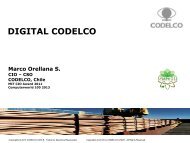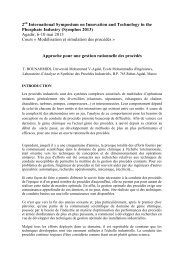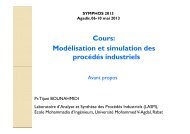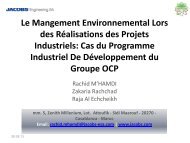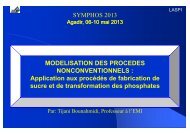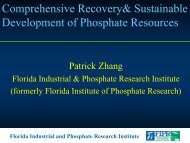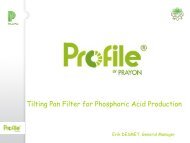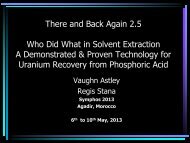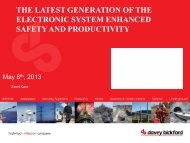Abstract SYMPHOS 2011
Abstract SYMPHOS 2011
Abstract SYMPHOS 2011
Create successful ePaper yourself
Turn your PDF publications into a flip-book with our unique Google optimized e-Paper software.
AP-O-08<br />
Marc Sonveaux,<br />
EcoPhos S.A., Centre Monnet, Av jean Monnet 1, B1348 Louvain-la-Neuve,<br />
BELGIUM<br />
Animal feed phosphate is the second most important field of use of phosphate in terms of production volume, after<br />
fertilizer. Two animal feed phosphate products are mainly used: DCP (CaHPO 4 .2H 2 O) and MCP (Ca(H 2 PO 4 ) 2 .H 2 O).<br />
The large majority of the producers of animal feed phosphate produce it by neutralization of purified/defluorated<br />
phosphoric acid. Most of the producers are not integrated from the mine to the final product. Therefore they have<br />
to buy phosphoric acid externally.<br />
Starting from rock, the conventional production process consists of 6 main steps:<br />
1. Rock digestion<br />
2. Liquid solid separation to remove phosphogypsum<br />
3. Phosphoric acid concentration<br />
4. Post treatment: fluoride removal, As removal, Cd removal, SO4 reduction<br />
5. DCP precipitation with CaCO3 or Ca(OH)2<br />
6. Final product filtration and drying<br />
The simplified reactions for DCP animal feed production are:<br />
Digestion:<br />
Ca 3 (PO 4 ) 2 + 3 H 2 SO 4 + 2 H 2 O à 2 H 3 PO 4 + 3 CaSO 4 .2H 2 O<br />
DCP precipitation:<br />
H 3 PO 4 + CaCO 3 + H2O à CaHPO 4 .2H 2 O + CO 2<br />
Since 1996, EcoPhos, a Belgian company has developed an alternative method to produce animal feed phosphate<br />
that reduces significantly the investment cost as well as the production cost of animal feed production plant. This<br />
process consists of the following steps:<br />
1. Soft rock digestion with dilute HCl: heavy metals and radioactive elements remains insoluble<br />
2. Liquid solid separation and removal of the heavy metals and radioactive elements as solid cake<br />
3. DCP precipitation with CaCO3 or Ca(OH)2<br />
4. Final product filtration and drying<br />
5. HCl recycling using H2SO4 and generating pure and not radioactive gypsum<br />
This new process allows also to reduce residence time for rock digestion to 45min and then reducing significantly<br />
the investment cost.<br />
Digestion: two reactions occurs<br />
Ca 3 (PO 4 ) 2 (s) + 4 HCl (l) à Ca(H 2 PO 4 ) 2 (l) + 2 CaCl 2 (l)<br />
Ca 3 (PO 4 ) 2 (s) + 6 HCl (l) à 2 H 3 PO 4 (l) + 3 CaCl 2 (l)<br />
DCP precipitation: two reactions occurs<br />
Ca(H 2 PO 4 ) 2 (l) + CaCO 3 (s) + 3 H 2 O à 2 CaHPO 4 .2H 2 O (s) + CO 2 (g)<br />
H 3 PO 4 + CaCO 3 + H 2 O à CaHPO 4 .2H 2 O + CO 2<br />
96<br />
NEW PROCESS TO CONVERT PHOSPHATE ROCK INTO ANIMAL FEED PHOSPHATE



